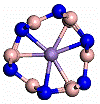Department of Physics and Astronomy: Publications and Other Research

Stephen Ducharme Publications
Document Type
Article
Date of this Version
2005
Abstract
The ferroelectric and piezoelectric properties of newly synthesized polymer systems have been studied. To date PVDF and its copolymers P(VDF-TrFE) have provided the bulk of the knowledge pertaining to ferroelectricity in polymers. Recently, ultrathin ferroelectric films of P(VDF-TrFE) 70:30 have been fabricated using the Langmuir-Blodgett technique [4]. In this study, various new polymers have been synthesized by chemically altering the PVDF structure. This alteration was performed in order to enhance the amphiphilic nature of the polymer and thus improve the LB film quality and control. Various chemical groups have been used to replace the electropositive hydrogen and electronegative fluorine found in the traditional PVDF chemical structure, including Nitrile, Ester, and Methyl groups. In all cases the resulting chemical structure provides for a net dipole moment directed from the electronegative side of the monomer to the electropositive side. However, to obtain ferroelectricity these microscopic dipoles must first pack in a manner such that a reversible macroscopic dipole is obtained. Both structural and dielectric studies have been performed on a number of newly synthesized systems. The structural properties of these new materials were probed using both temperature-dependent x-ray diffraction and differential scanning calorimetry, while dielectric properties were investigated using electric field and temperature-dependent capacitance and polarization measurements.

